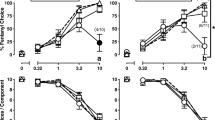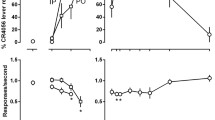Abstract
The experiments characterized the effects of fentanyl, morphine, naloxone, cyclazocine, nalorphine, ketocyclazocine and N-allylnormetazocine in rats that were trained to discriminate 0.04 mg/kg from 0.02 mg/kg fentanyl (dose-dose discrimination). The data are compared to results obtained previously in rats discriminating 0.04 mg/kg fentanyl from saline (drug-saline discrimination). In the dose-dose discrimination fentanyl and morphine produced responding appropriate to 0.04 mg/kg fentanyl at doses which were 3.0- and 1.6-fold higher, respectively, than in drug-saline discrimination. Naloxone antagonized the stimulus effects of 0.04 mg/kg fentanyl at 9.8-fold lower doses than in drug-saline discrimination. The dose-effect curves of fentanyl and naloxone in rats discriminating 0.04 mg/kg from 0.02 mg/kg fentanyl, were steeper than in rats discriminating 0.04 mg/kg fentanyl from saline. While cyclazocine, nalorphine and N-allylnormetazocine acted as mixed and partial agonists/antagonists in drug-saline discrimination, those compounds acted as pure and complete antagonists of 0.04 mg/kg fentanyl in dose-dose discrimination. The rank order of compounds in antagonizing the stimulus effects of 0.04 mg/kg fentanyl in dose-dose discrimination was naloxone > N-allylnormetazocine > cyclazocine > nalorphine. It is suggested that a greater magnitude of opiate activity is required for producing generalization with the same 0.04 mg/kg dose of fentanyl in dose-dose as compared with drug-saline discrimination. Dose-dose discrimination may afford a more accurate method than drug-saline discrimination for assessing the equivalence of the discriminative stimulus properties of drugs. The data obtained in the present study are consistent with the hypothesis that the discriminative stimulus effects of the opiate compounds studied are mediated by a molecular mechanism involving only a single opiate receptor.
Similar content being viewed by others
References
Ariëns EJ (1964) The mode of action of biologically active compounds. In: Molecular pharmacology, vol. 1. Academic Press, New York
Colpaert FC (1978) Discriminative stimulus properties of narcotic analgesic drugs. Pharmacol Biochem Behav 9:863–887
Colpaert FC (1982a) Increased naloxone reversibility in fentanyl dose-dose discrimination. Eur J Pharmacol 84:229–231
Colpaert FC (1982b) The pharmacological specificity of opiate drug discrimination. In: Colpaert FC, Slangen JL (eds) Drug discrimination: applications in CNS pharmacology. Elsevier Biomedial Press, Amsterdam, pp 3–16
Colpaert FC (1985) Drug discrimination: Methods of manipulation, measurement and analysis. In: Bozarth MA (ed) Methods of assessing the reinforcing properties of abused drugs. Haer Institute, Brunswick, Maine (in press)
Colpaert FC (1986) Drug discrimination: Behavioral, pharmacological, and molecular mechanisms of discriminative drug effects. In: Goldberg SR and Stolerman IP (eds) Behavioral analysis of drug dependence. Academic Press, New York, pp 161–193
Colpaert FC, Janssen PAJ (1982) Factors regulating drug cue sensitivity: the effects of dose ratio and absolute dose level in the case of fentanyl dose-dose discrimination. Arch Int Pharmacodyn Thér 258:283–299
Colpaert FC, Janssen PAJ (1984) Agonist and antagonist effects of prototype opiate drugs in rats discriminating fentanyl from saline: characteristics of partial generalization. J Pharmacol Exp Ther 230:193–199
Colpaert FC, Niemegeers CJE, Janssen PAJ (1976) On the ability of narcotic antagonists to produce the narcotic cue. J Pharmacol Exp Ther 197:180–187
Colpaert FC, Niemegeers CJE, Janssen PAJ (1978) Changes of sensitivity to the cueing properties of narcotic drugs as evidenced by generalization and cross-generalization experiments. Psychopharmacology 58:257–262
Gilbert PE, Martin WR (1976) The effect of morphine- and nalorphine-like drugs in the nondependent, morphine-dependent and cyclazocine-dependent chronic spinal dog. J Pharmacol Exp Ther 198:66–82
Hein DW, Young AM, Herling S, Woods JH (1981) Pharmacological analysis of the discriminative stimulus characteristics of ethylketazocine in the Rhesus monkey. J Pharmacol Exp Ther 218:7–15
Herling S, Woods JH (1981) Discriminative stimulus effects of narcotics: Evidence for multiple receptor-mediated actions. Life Sci 28:1571–1584
Holtzman SG (1982a) Stimulus properties of opioids with mixed agonist and antagonist activity. Fed Proc 41:2328–2332
Holtzman SG (1982b) Discriminative stimulus properties of opioids in the rat and squirrel monkey. In: Colpaert FC, Slangen JL (eds) Drug discrimination: applications in CNS pharmacology. Elsevier Biomedical Press, Amsterdam, pp 17–36
Iwamoto ET, Martin WR (1981) Multiple opioid receptors. Med Res Rev 1:411–440
Janssen PAJ, Niemegeers CJE, Dony JGH (1963) The inhibitory effect of fentanyl (R 4263) and other morphine-like analgesics on the warm water induced tail withdrawal reflex in rats. Arzneimittelforsch 13:502–507
Jasinski DR (1972) Effects in man of partial morphine agonists. In: Kosterlitz HW, Collier HOJ, Villarreal JE (eds) Agonist and antagonist actions of narcotic analgesic drugs. MacMillan, London, pp 94–103
Leander JD (1982) Effects of ketazocine, ethylketazocine and phenazocine on schedule-controlled behavior: antagonism by naloxone. Neuropharmacology 21:923–928
Litchfield JT, Wilcoxon F (1949) A simplified method for evaluating dose-effect experiments. J Pharmacol Exp Ther 96:99–113
Martin WR (1967) Opioid antagonists. Pharmacol Rev 19:463–521
Martin WR, Eades CG, Thompson JA, Huppler RE, Gilbert PE (1976) The effects of morphine- and nalorphine-like drugs in the nondependent and morphine-dependent chronic spinal dog. J Pharmacol Exp Ther 197:517–532
Shannon HE (1983) Pharmacological evaluation of N-allylnormetazocine (SKF 10,047) on the basis of its discriminative stimulus properties in the rat. J Pharmacol Exp Ther 225:144–152
Shearman GT, Herz A (1982a) Generalization and antagonism studies with rats trained to discriminate an effect of the proposed sigma opiate receptor agonist N-allylnormetazocine (SKF 10,047). In: Colpaert FC, Slangen JL (eds) Drug discrimination: applications in CNS pharmacology. Elsevier Biomedical Press, Amsterdam, pp 37–47
Shearman GT, Herz A (1982b) Evidence that the discriminative stimulus properties of fentanyl and ethylketocyclazocine are mediated by an interaction with different opiate receptors. J Pharmacol Exp Ther 221:735–739
Siegel S (1956) Nonparametric statistics. McGraw-Hill Book Co., New York
Tang AH, Code RA (1983) Discriminative stimulus properties of nalorphine in the Rhesus monkeys. J Pharmacol Exp Ther 227:563–569
Teal JJ, Holtzman SG (1980) Discriminative stimulus effects of cyclazocine in the rat. J Pharmacol Exp Ther 212:368–376
Terrace HS (1966) Stimulus control. In: Honig WK (ed) Operant behavior: areas of research and application. Appleton-Century-Crofts, New York, pp 66–78
Author information
Authors and Affiliations
Rights and permissions
About this article
Cite this article
Colpaert, F.C., Janssen, P.A.J. Agonist and antagonist effects of prototype opiate drugs in fentanyl dose-dose discrimination. Psychopharmacology 90, 222–228 (1986). https://doi.org/10.1007/BF00181246
Received:
Revised:
Issue Date:
DOI: https://doi.org/10.1007/BF00181246




